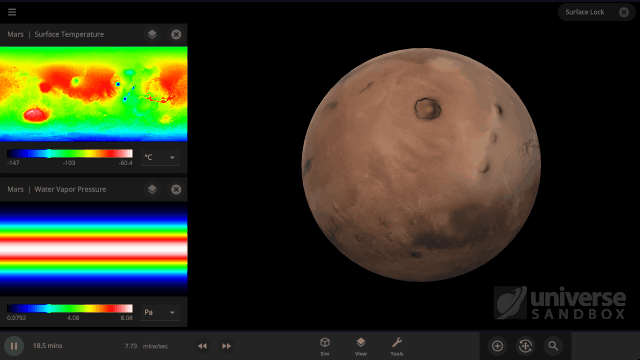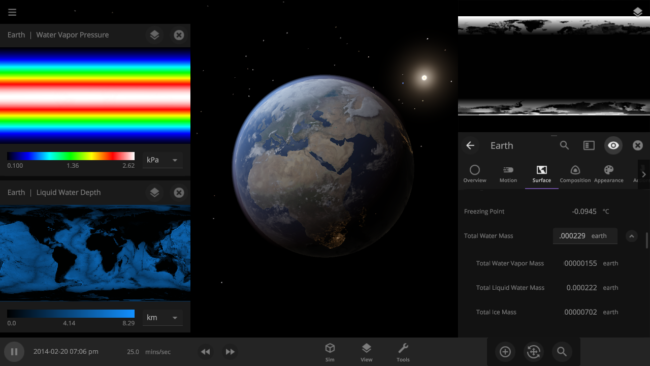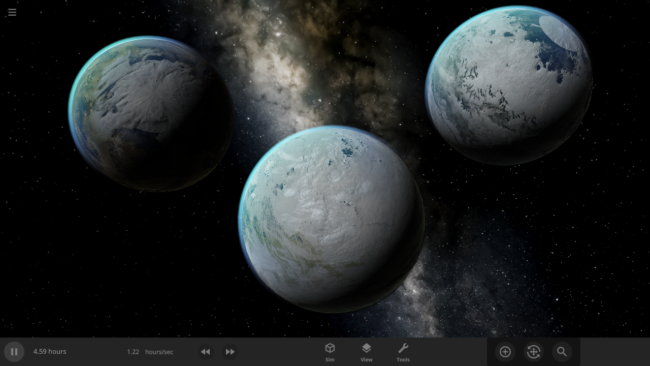Simulating Snow | ScienceLog #4


It turns out it’s a lot harder to simulate snow, or any weather for that matter, than it is to simulate regular surface water. In Universe Sandbox the phases of water on the surface of an object depend just on the sea level temperature, and we even make sure to conserve the total surface water mass in all of its phases, which you can find under Properties > Surface > Total Water Mass. However, because snow depends on so many other conditions we don’t keep track of it in the same way.

Like all phases of water, snow is also tracked with surface grids, which we discussed in our first ScienceLog. We simulate snow by checking if each point on the surface grid has the right elevation, amount of water vapor, and surface temperature, needed for snow to form. If the point meets all of our checks, we know snow needs to be added to that point. This is much more complex than how we simulate ice, which only depends on whether the sea level temperature of a point on the surface grid is below freezing.
As of Update 27 we’re also keeping a record of where snow is being formed. One thing this allows us to do now is add and remove snow more realistically. This is a big improvement over our previous snow simulation where snow would just appear and disappear instantaneously depending on the properties of each point on the surface grid at any given time. We’re also doing a better job of simulating snow and ice on random planets by stabilizing the water phases and then running our snow checks when the planet is created.

At the Speed of Snow
Now, you may be wondering why we don’t just simulate snow with the rest of the phases of water. To do that, we would need to simulate the entire water cycle, which we just can’t do accurately at simulation speeds faster than about one second per second on a desktop computer (yet). Even organizations like NASA need supercomputers to accurately simulate weather! This limitation comes from how fast we can allow water to flow through the points on a surface grid and maintain a stable surface simulation. In the water cycle, the phases change much faster than we can simulate the flow rate of water. This means we can’t keep track of which points should have which phases. For simulating the phase changes of water on the surface of a planet, like liquid water to ice, we aren’t limited because the flow rate of water is faster than the phase changes of this surface water. However, as consumer computers get faster, our snow simulation has the potential to become more realistic. So while we may not have personal supercomputers anytime soon, you can still check out how much better snow looks by checking out the Tidally Locked Earth or Mars Collisions Sims.
This blog post is part of our ongoing series of ScienceLog articles, intended to share the science behind some of Universe Sandbox’s most interesting features. If you would love to learn about the real-life science powering our simulator, please stay tuned and let us know what you would like to read about next.
To join our community discussions, please join us on our Steam Forum and our official Discord community.

about 3 years ago
I have read the past ScienceLog #3 last time about how long it would take for the Earth’s oceans to totally freeze.
Now, I have a good suggestion for the next ScienceLog #5. Lets do the opposite for Earth’s oceans. How long would it take for Earth’s oceans to boil into steam if placed in the orbit of Venus?
about 1 years ago
I have never used this before but it looks awsome
about 1 years ago
I think that we can actually learn from this.
about 1 years ago
I really want to use this.
about 1 years ago
Thank you for your interest in Universe Sandbox!
Universe Sandbox can be purchased on our website:
http://universesandbox.com/buy
This purchase uses the Humble Bundle service and will give you a key that you can redeem on Steam.
You can get a stand-alone copy, as well as a key for Steam, by purchasing from itch.io:
https://universesandbox.com/buy/itch
You can also purchase directly from Steam:
https://universesandbox.com/buy/steam
Alternatively, you can bypass Steam completely and purchase a stand-alone copy from GOG:
https://universesandbox.com/buy/gog
We are also available on the Epic Games Store:
https://universesandbox.com/buy/epic
And the Microsoft Store:
https://universesandbox.com/buy/microsoftstore